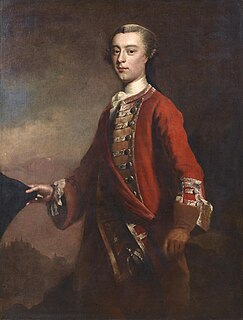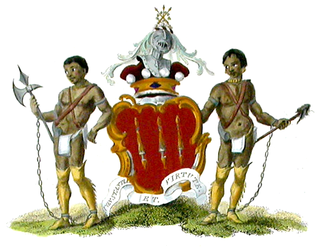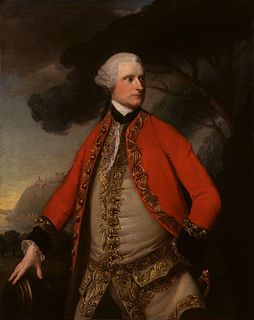

Montreal Park is a development in Sevenoaks in Kent which was formerly the home of Lord Amherst, Commander-in-Chief of the Forces. It was named after his conquest of Montreal in 1760.


Montreal Park is a development in Sevenoaks in Kent which was formerly the home of Lord Amherst, Commander-in-Chief of the Forces. It was named after his conquest of Montreal in 1760.
In 1764 Lord Amherst returned home after his military successes during the Seven Years' War and commissioned a large house at Sevenoaks in Kent built in the Palladian style. [1] On 30 August 1788 he was created, additional to his other title of Holmesdale, [2] Baron Amherst of Montreal. [3]
In 1926 the house was sold to Julius Runge, a businessman, who allowed it to fall into disrepair. [1] The house was demolished in 1936 and replaced between 1952 and 1963 by a housing development promoted by a local builder, William Fasey. [1] Montreal Park Lake is owned by the Holmesdale Angling and Conservation Society. [4]
Today all that remains to remind us of Lord Amherst is an octagonal gatehouse, a derelict stone summerhouse and large obelisk. [5]
The inscription on the obelisk reads: [5]
To commemorate the providential and happy meeting of three brothers on this their Paternal ground on 25 January 1761 after a six years glorious war in which the three were successfully engaged in various climes, seasons and services.
Dedicated to that most able Statesman during whose Administration Cape Breton and Canada were conquered and from whose influence the British Arms derived a Degree of Lustre unparalleled in past ages.
Louisbour surrendered and Six French Battalions Prisoners of War 26 July 1758
Du Quesne taken possession of 24 November 1758
Niagara surrendered 25 July 1759
Ticonderoga taken possession of 26 July 1759
Crown Point taken possession of 4 August 1759
Quebec capitulated 18 September 1759
Fort Levi surrendered 25 August 1760
Ile au Noix abandoned 28 August 1760
Montreal surrendered and with it all Canada and 10 French Battalions laid down their Arms 8 September 1760St Johns Newfoundland retaken 18 September 1762

Field Marshal Jeffery Amherst, 1st Baron Amherst, was a British Army officer and Commander-in-Chief of the Forces in the British Army. Amherst is credited as the architect of Britain's successful campaign to conquer the territory of New France during the Seven Years' War. Under his command, British forces captured the cities of Louisbourg, Quebec City and Montreal, as well as several major fortresses. He was also the first British Governor General in the territories that eventually became Canada. Numerous places and streets are named for him, in both Canada and the United States.

James Wolfe was a British Army officer known for his training reforms and remembered chiefly for his victory in 1759 over the French at the Battle of the Plains of Abraham in Quebec as a major general. The son of a distinguished general, Edward Wolfe, he received his first commission at a young age and saw extensive service in Europe during the War of the Austrian Succession. His service in Flanders and in Scotland, where he took part in the suppression of the Jacobite Rebellion, brought him to the attention of his superiors. The advancement of his career was halted by the Peace Treaty of 1748 and he spent much of the next eight years on garrison duty in the Scottish Highlands. Already a brigade major at the age of 18, he was a lieutenant-colonel by 23.

Field Marshal John Griffin Griffin, 4th Baron Howard de Walden, 1st Baron Braybrooke, , KB, of Audley End in Essex, was a British nobleman and soldier. He served as a junior officer with the Pragmatic Army in the Netherlands and Germany during the War of the Austrian Succession. After changing his surname to Griffin in 1749, he commanded a brigade of at least four battalions at the Battle of Corbach in July 1760 during the Seven Years' War. He also commanded a brigade at the Battle of Warburg and was wounded at the Battle of Kloster Kampen.

Events from the year 1759 in Canada.

Events from the year 1760 in Canada.

Earl Amherst, of Arracan in the East Indies, was a title in the Peerage of the United Kingdom. It was created on 19 December 1826, for William Amherst, 2nd Baron Amherst, the Governor-General of India. He was made Viscount Holmesdale, in the County of Kent, at the same time, also in the Peerage of the United Kingdom.

General James Murray was a British Army officer and colonial administrator who served as the governor of Quebec from 1760 to 1768 and governor of Minorca from 1778 to 1782. Born in Ballencrieff, East Lothian, Murray travelled to North America and took part in the French and Indian War. After the conflict, his administration of the Province of Quebec was noted for its successes, being marked by positive relationships with French Canadians, who were reassured of the traditional rights and customs. Murray died in Battle, East Sussex in 1794.

William Archer Amherst, 3rd Earl Amherst, styled Viscount Holmesdale from 1857 to 1886, was a British peer, politician and notable Freemason.

Riverhead is a northern village part of the urban area of Sevenoaks in the district of the same name in Kent, England and is also a civil parish. The parish had a population in 2001 of 1821, increasing to 2,634 at the 2011 Census.
Field Marshal Lord Frederick Cavendish was a British Army officer and Whig politician. After serving as an aide-de-camp to the Duke of Cumberland in Germany during the early stages of the Seven Years' War, he served under Charles Spencer, 3rd Duke of Marlborough in the raid on St Malo and then took part in the raid on Cherbourg. Cavendish commanded the rear-guard during the re-embarkation following the disastrous battle of Saint Cast and was taken prisoner. After his release, Prince Ferdinand of Brunswick gave him command of a brigade of chasseurs which he led to victory at the Battle of Wilhelmsthal in June 1762.

The 55th Regiment of Foot was a British Army infantry regiment, raised in 1755. After 1782 it had a county designation added, becoming known as the 55th (Westmorland) Regiment of Foot. Under the Childers Reforms it amalgamated with the 34th (Cumberland) Regiment of Foot to form the Border Regiment in 1881.
The 65th Regiment of Foot was an infantry regiment of the British Army, raised in 1756 as the 2nd Battalion, 12th Regiment of Foot. Under the Childers Reforms it amalgamated with the 84th Regiment of Foot to become the 1st Battalion, York and Lancaster Regiment in 1881.

The Fort de La Présentation, a mission fort, was built in 1749 and so named by the French Sulpician priest, Abbé Picquet. It was also sometimes known as Fort La Galette. It was built at the confluence of the Oswegatchie River and the St Lawrence River in present-day New York. The French wanted to strengthen their alliance with the powerful Iroquois, as well as convert them to Catholicism. With increasing tensions with Great Britain, they were concerned about their thinly populated Canadian colony. By 1755 the settlement included 3,000 Iroquois residents loyal to France, in part because of the fur trade, as well as their hostility to encroachment by British colonists in their other territories. By comparison, Montréal had only 4,000 residents.

Lieutenant General William Amherst was a British military commander. In 1762 during the Seven Years' War he led British forces that defeated a French expedition which had occurred earlier that year in St. John's, Newfoundland at the Battle of Signal Hill.

The siege of Louisbourg was a pivotal operation of the Seven Years' War in 1758 that ended the French colonial era in Atlantic Canada and led to the subsequent British campaign to capture Quebec in 1759 and the remainder of French North America the following year.
Lieutenant-General James Murray, was a Scottish soldier and politician who sat in the House of Commons from 1773 to 1794.

William Pitt Amherst, 2nd Earl Amherst, styled Viscount Holmesdale between 1826 and 1857, was a British peer.
John Knox was an officer in the British Army who took part in the Austrian War of Succession and the Seven Years' War. He served in North America between 1757 and 1760 and is notable for providing historians with the most complete account of these campaigns. Knox narrowly avoided being killed in 1759 when a French soldier's musket twice misfired, and he went on to fight in the Battle of the Plains of Abraham, where he performed in one of the most devastating volleys in military history. Knox also took part in the Battle of Sainte Foy and was present when Montreal surrendered on 8 September 1760.

The Montreal Campaign, also known as the Fall of Montreal, was a British three-pronged offensive against Montreal which took place from July 2 to 8 September 1760 during the French and Indian War as part of the global Seven Years' War. The campaign, pitted against an outnumbered and outsupplied French army, led to the capitulation and occupation of Montreal, the largest remaining city in French Canada.
The Kent Militia was an auxiliary military force in Kent in the South East England. From their formal organisation as Trained Bands in 1558 until their final service as the Special Reserve, the Militia regiments of the county served in home defence in all of Britain's major wars. They also saw active service during the Second Boer War, and trained thousands of reinforcements during World War I. After a shadowy postwar existence they were formally disbanded in 1953.